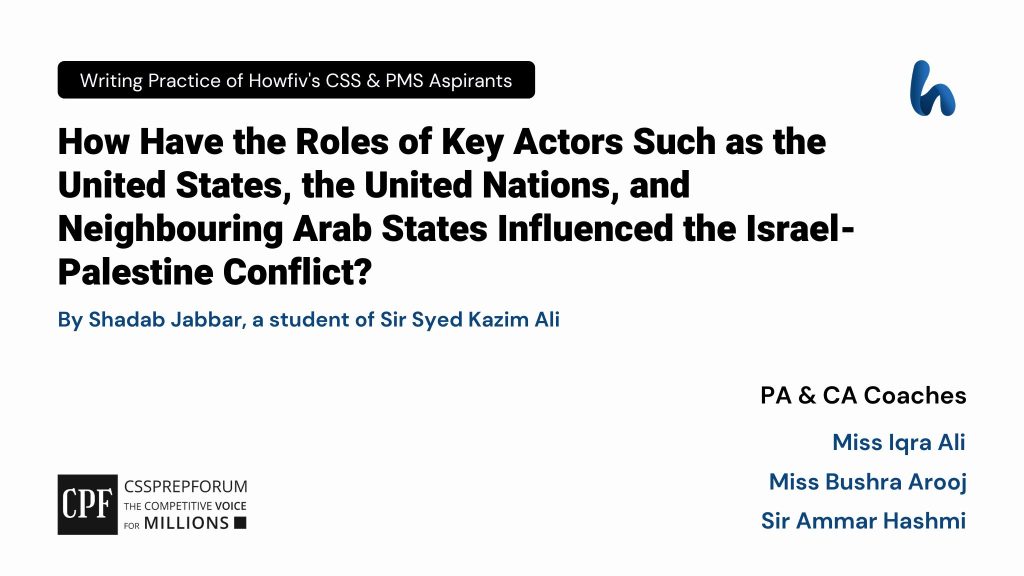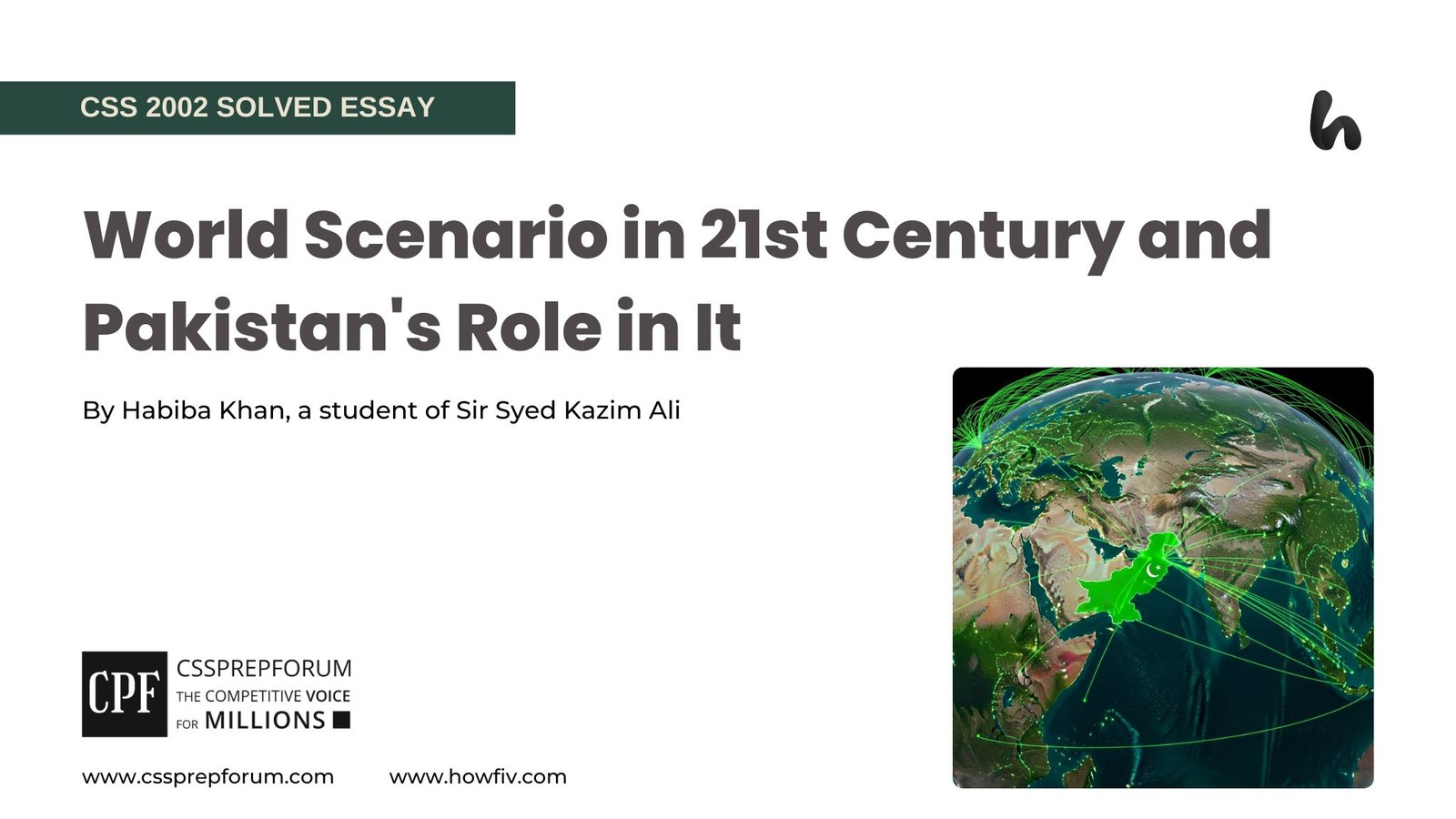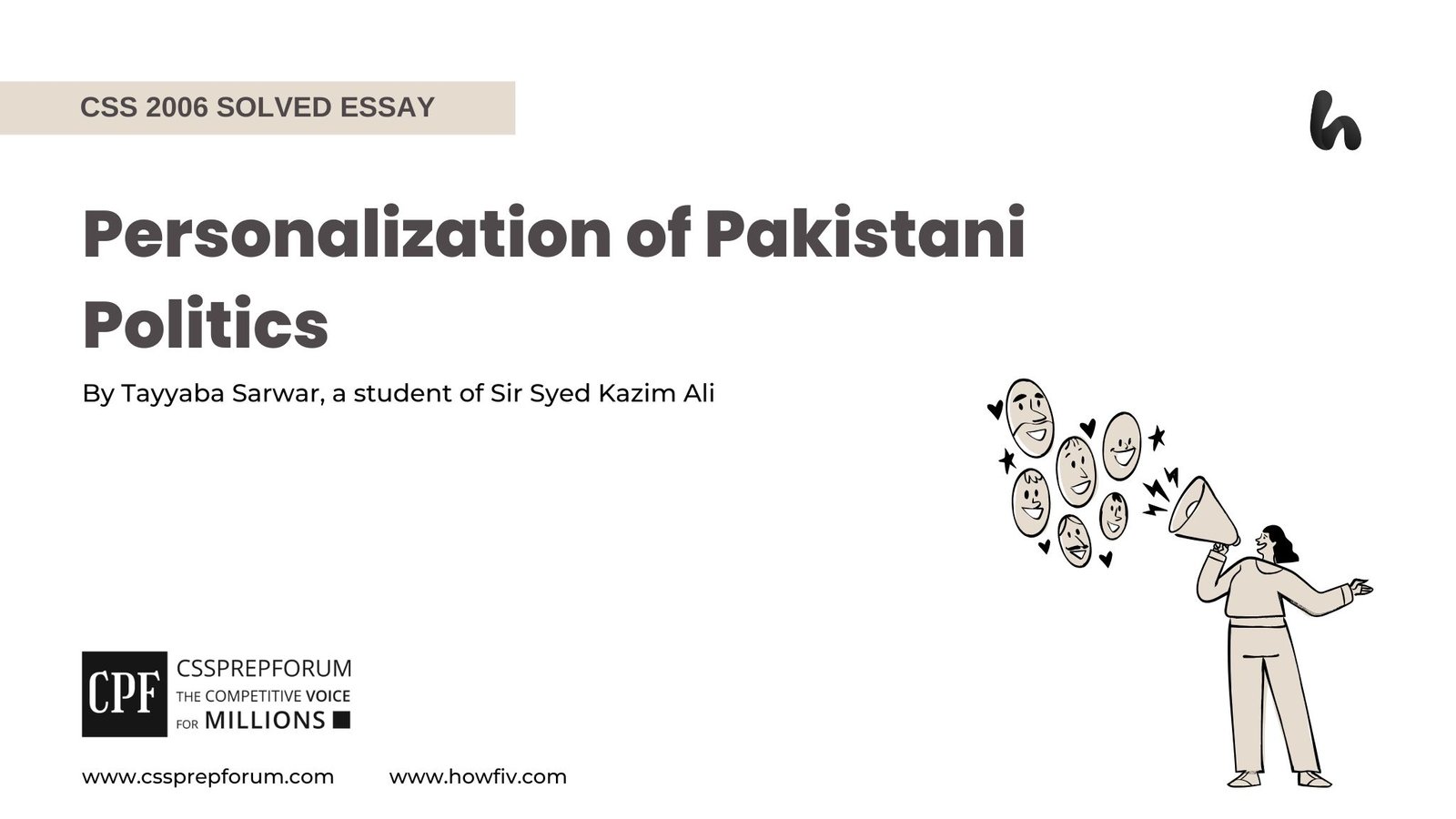International Key Actors and the Israel-Palestine Conflict | Daily Writeup | Opinions
The following article of CSS Pakistan Affairs is solved by Shadab Jabbar under the supervision of Howfiv’s Pakistan Affairs Coaches. She learnt how to attempt 20 marks question and essay writing from Sir Syed Kazim Ali, Pakistan’s best CSS and PMS English essay and precis teacher with the highest success rate of his students. This solved past paper question is attempted on the pattern taught by Sir to his students, scoring the highest marks in compulsory and optional subjects for years, and uploaded to help aspirants understand how to crack a topic or question, how to write relevantly, what coherence is, and how to include and connect ideas, opinions, and suggestions to score the maximum.

Outline
1- Introduction
2- Contemporary dynamics of the Israel-Palestine conflict
3- Role of the key actors in influencing the conflict
3.1- The United States
- ✓Diplomatic Influence
- Case in point: Henry Kissinger’s shuttle diplomacy between the Middle Eastern capitals
- The Camp David Accords brokered by the United States President
- Final signing of Oslo Accords
- The Abraham Accords
- ✓Influence in strengthening Israel’s position
- Case in point: The use of veto power by the United States to block any resolution condemning Israel
- Israel is the biggest aid recipient of America
3.2- The United Nations
- ✓The two-state solution and the Resolution 181
- Case in point: Two autonomous states, one for the Palestinian Arabs and the other for the Jews, and Jerusalem would have an internationalized status
- ✓Mediatory efforts and humanitarian aid
- Case in point: Resolutions 242 and 338
- The Madrid Peace Conference
- Granting Palestine the status of a non-member observer state
- Aid through the United Nations Relief and Work Agency (UNRWA) and the World Health Organisation (WHO)
3.3- The neighbouring Arab States
- ✓The wider ambit: Arab-Israel Wars shaping the course of the conflict
- Case in point: Egypt, Jordan, Syria, Lebanon, and Iraq played a significant role in the Arab-Israel Wars
- ✓Shift towards normalization
- Case in point: Normalization of relations between Israel and the Arab States through peace negotiations like the Camp David Accords, the Isreal Jordan Peace talks, and the Abraham Accords
4- Way Forward
5- Conclusion

Answer to the Question
1- Introduction
The Israel-Palestine conflict dates back to the late nineteenth century and early twentieth century. It resulted from the clash between the Zionist aspirations for a Jewish state and the Palestinian Arab resistance against colonialism by foreign actors. In 1948, the State of Israel came into being, which resulted in the displacement of millions of Palestinians and a refugee crisis that has persisted till the current era. This development was a repercussion of the Jewish immigration waves to Palestine, which, back then, was a mandate of the British Empire and the aftermath of the Word War II. However, the conflict’s boundaries have been altered by various influential actors comprising the subsequent wars, territory gains, strategic alliances, vested interests, nationalism, and diplomatic initiatives, consequently leaving behind a spirit of resentment, trauma, and unresolved grievances on both sides.
2- Contemporary dynamics of the Israel-Palestine
The latest conflict between the two states began on October 7, 2023, exactly fifty years and one day after the last Arab-Israel war of 1973. Hamas, a Palestinian armed group, launched an unprecedented attack on Israel by launching missiles into the country and invading southern Israeli territories across the Gaza Strip border. As a result, about 1,200 individuals, including soldiers and civilians, lost their lives; several people were wounded and kidnapped. Although, initially, Israel was caught off-guard by the attack, it quickly retaliated with a lethal counterattack. A “complete siege” on Gaza was ordered to be imposed at the hands of the Israel Defence Forces (IDF) by the Defence Minister of Tel Aviv following the country’s cabinet’s official war declaration against Hamas. According to a report by Oxfam International, about 250 Palestinian citizens are killed by the Israeli military on a daily basis, and many more are at risk of starvation, disease, and cold. This death toll is more than the result of any other significant conflict in recent years. As of May 2024, over 37,000 individuals have lost their lives, including 35,562 Palestinians and 1,478 Israelis. Among the dead are included about 105 journalists and over 224 humanitarian relief workers.
3- Role of the key actors in influencing the conflict
3.1- The United States
- ✓Diplomatic Influence
The United States has proclaimed itself a mediator in the Israel-Palestine conflict; it has initiated multiple talks and negotiations with the goal of reducing the confrontation. Additionally, Washington has provided a substantial amount of financial aid to fund the peace process. Given the diplomatic efforts and monetary support, America has established itself as the state most actively engaged in finding a settlement to the conflict. However, the confrontation has proven to be challenging to settle since both the involved parties have continued to struggle for their colliding claims of sovereignty over the same region.
Even though After the 1967 War, Washington made efforts for the resolution of the wider Arab-Israel conflict, it positioned itself as a cornerstone in leading the future diplomacy after the 1973 conflict. Henry Kissinger’s-former US Secretary of State- shuttle diplomacy between the Middle Eastern capitals in 1974 and 1975 contributed to the de-escalation of hostilities and the disentanglement of the combatants. Furthermore, the US President of the time, Jimmy Carter, facilitated the Camp David Accords that laid down the framework for further diplomatic prospects between Egypt and Israel. The final signing of the Oslo Peace Accords took place at the White House in 1993; Israel recognized Palestine’s autonomy in Gaza and the West Bank, and the Palestinian authorities accepted Israel’s right to exist. In addition, different US administrators have put forth their own ideas for a two-state solution, including Donald Trump’s Peace to Prosperity Plan, Clinton’s Clinton Parameter, John Kerry’s Six Principles, and George W. Bush’s Road Map to Peace. Other than this, as recently as 2020, the Trump administration brokered a peace agreement, the Abraham Accords, in order to normalize relations between Israel and multiple Arab states.
- ✓Influence in strengthening Israel’s position
The US was the first state that recognized Israel as a legitimate Jewish State in 1948. The diplomatic ties between Tel Aviv and Washington have remained tight-knit, which has had a negative impact on the resolution of the conflict. Critics argue that America has posed as Israel’s big brother, defending and justifying its conduct in war while brokering the deals between the parties. Since the 1970s, the United States has displayed its bias by exploiting its status as a permanent member of the Security Council of the UN by using its veto power as much as 46 times, repeatedly blocking resolutions that would have condemned Israel. Besides, Israel is the biggest aid recipient of America, having received about 260 billion USD. Tel Aviv also receives an additional around 4 billion USD worth of military aid from Washington annually as a part of a negotiation carried out under the administration of Barack Obama in 2016. Moreover, The United States has continued to extend its unwavering support to Israel throughout history, including Trump’s recognition of Tel Aviv’s illegal claim over Jerusalem and Joe Biden’s administration’s provision of military aid, persistent blocking of UN resolutions, and the maintained stance favouring Israel’s right to defend itself in the current confrontation.
3.2- The United Nations
- ✓The two-state solution and Resolution 181
The Israel-Palestine conflict is almost as old as the United Nations itself. Soon after the Second World War, the Palestine question was taken to the UN. In 1947, the organization developed the UN’s Special Committee on Palestine (UNSCOP), comprising delegates from eleven countries. The committee published a report proposing a two-state solution for the resolution of the conflict: Two autonomous states, one for Palestinian Arabs and the other for Jews, while Jerusalem would have an internationalized status. Hence, the UN General Assembly adopted the resolution, Resolution 181, and the Israeli Declaration of Independence took place on May 14, 1948. However, the partition proposal faced strong opposition from the Arab Palestinian leadership, followed by the eruption of civil war posing hindrances to its implementation.
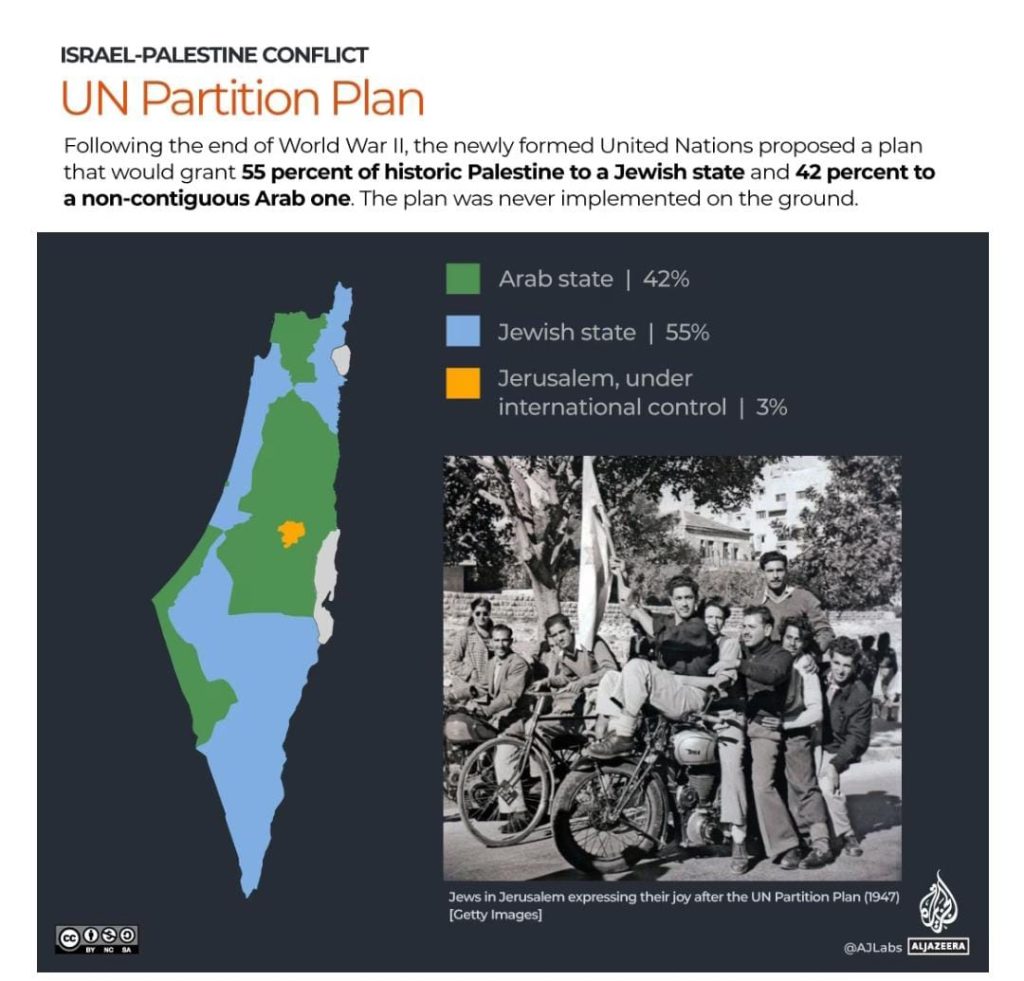
- ✓Mediatory efforts and humanitarian aid
The United Nations has passed various resolutions to mediate the Israel-Palestine conflict. For instance, the UNSC passed Resolution 242 and Resolution 338 after the 1967 and 1973 Wars, respectively. These resolutions emphasized the establishment of lasting peace through negotiations between the relevant parties. Other than this, in 1974, the Palestinian Liberation Organisation (PLO) was granted the UN observer status, and in 1975, the UNGA constituted the Committee on the Exercise of the Inalienable Rights of the Palestinian People (CEIRPP). Furthermore, the two resolutions manifested in the 1991 Madrid Peace Conference, which was centred on the realization of direct talks between not only Israel and its neighbouring Arab states but also Israel and the Palestinians. Moreover, in 2012, the international organization granted Palestine the non-member observer state status.
While throughout the years, the UN has passed numerous resolutions with the hope of conflict resolution, it has not been very successful in safeguarding the rights of Palestinian citizens in the face of the atrocities imposed by Israel. The organization has been criticized for being under the influence of the global North, particularly the United States, which is a long-standing ally of Israel and has stood solid against any resolution holding Israel accountable by using its veto power. Nevertheless, the United Nations Secretary-General has called for a ceasefire multiple times, stressing to put an end to the “vicious cycle of bloodshed, hatred, and polarization.” In addition, the UN, through the United Nations Relief and Works Agency for Palestine Refugees in the Near East (UNRWA) and the World Health Organisation (WHO), has been trying to provide assistance and refuge to the people of Palestine. However, the aid is not sufficient for the Palestinians and faces delays in reaching them because of being monitored by Israel.
3.3- The neighbouring Arab States
- ✓The wider ambit: Arab-Israel Wars shaping the course of the conflict
The neighbouring Arab states have played a significant role in influencing the Israel-Palestine war. Some states actively participated in the confrontation from the very beginning, while others took time before presenting themselves. For instance, the conflict snowballed into an issue of the whole region when Egypt, Syria, Lebanon, Iraq, and Jordan, opposing the illegal zionist settlements, invaded Israel following its independence in 1948. This First Arab Israel, also known as the Nakba, led to the internal displacement of about 0.75 million Palestinians. Israel captured Jerusalem, while Egypt took over the Gaza Strip, and Jordan occupied the West Bank. Furthermore, in the Second Arab-Israel War of 1956, Israel, with the support of France and Britain, attacked Egypt. The attack was launched after the nationalization of the Suez Canal by the country’s President, Gamal Abdel Nasser. Egypt did not face defeat in the face of the tripartite aggression, but Israel got access to its shipping rights in the Straits of Tiran. Another upheaval occurred in 1967, marking the outset of the Six-Day War, followed by Israel’s victory and the defeat of Jordan, Egypt, and Syria. This war resulted in Israel gaining territorial control over several areas of the opposing parties: Egypt’s Gaza Strip and the Sinai Peninsula, Syria’s Golan Heights, and Jordan’s West Bank. Furthermore, the Yom Kippur War started in 1973 after Egypt and Syria-backed by Jordan, Lebanon, Iraq, Kuwait, Algeria, and Sudan launched an unexpected attack on Israel from two fronts. Anwar-al-Sadat, the president of Egypt, pronounced the war a success since it created the opportunity for Egypt and Syria to carry out talks on previously lost territories.
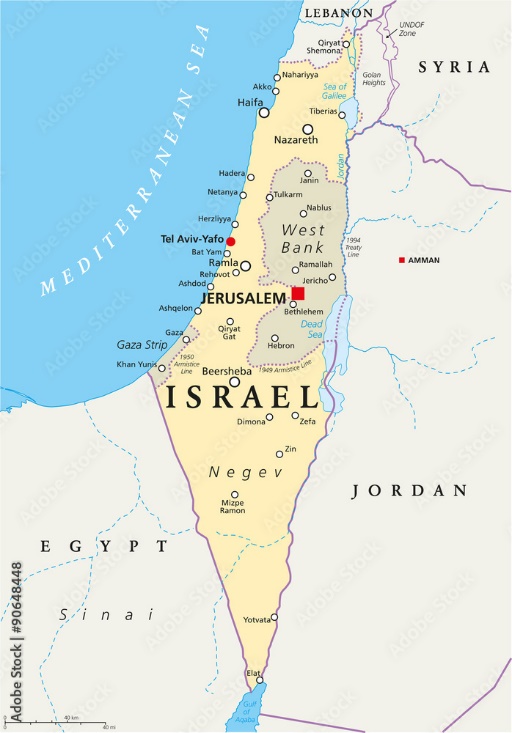
- ✓Shift towards normalization
The question of Palestine remained unresolved after the four armed confrontations between the Arab states and Israel. However, the relations between Israel and the neighbouring countries keep evolving into a more normalized state through various negotiations. For Example, the 1973 Arab-Israel War, which is also recognized as the October War, the Ramadan War, or the Yom Kippur War, led to a number of cease-fire and peace negotiations. The Peace Deal at Camp David in 1978 was a major development after the thirty years of conflict between Egypt and Israel. It was the first treaty of its kind between the two nations, which was brokered by the United States, proposing the terms for the prospects of peace in the region. Moreover, Jordan also established peace with Israel after being invaded twice in 1978 and 1982, with the aim of wiping out the Palestine Liberation Organisation. The Jordan-Israel Peace Treaty was signed in 1994 by the two countries, which agreed on the restoration of Jordan’s occupied territory. Another such normalization of relations can be seen in the Abraham Accords of 2020, which led to Bahrain and the UAE (United Arab Emirates) recognizing the State of Israel in September and Morocco following suit in December of the same year.
4- Way Forward
In the wake of recent events, protests all around the world have escalated, demanding an immediate cease-fire of the war. It is of utmost importance that the international community recognizes its responsibility and comes together, taking measures directed at the realization of this objective. Additionally, out of the multiple proposed resolutions of the conflict, the two-state solution seems most palpable. The influential, especially the United States, the United Nations, and the West Asian neighbours of Israel and Palestine-must play their part in accordance with international law to establish peace and make the two-state solution possible. The Palestinians should be given their right to self-determination and sovereignty, whereas the responsible actors should be held accountable without biases.
5- Conclusion
In a nutshell, the Israel-Palestine conflict dates back to the establishment of Zionist settlements after the two-state solution proposed by the United Nations in the British Mandate of Palestine. However, the confrontation has been far from being a bilateral issue. Various key actors have played significant roles in staying influential throughout the many decades of the multi-dimensional war. The course of events comprising the Israeli-Palestine war has been shaped by some vested interests, long-term alliances, nationalist spirits, and diplomatic and mediatory efforts. While the stance of the key actors has seen a transformation over time, the question of Palestine has persisted still. Moreover, the United Nations and the United States have stayed significant in the war by making attempts at conflict resolutions; however, both have faced criticism for their biased shortcomings. Meanwhile, most of the neighbouring Arab states became a party to the war in support of Palestine but have gradually shifted towards normalizing the relations with Tel Aviv through various peace negotiations.

CSS Solved Past Papers’ Essays
Looking for the last ten years of CSS and PMS Solved Essays and want to know how Sir Kazim’s students write and score the highest marks in the essays’ papers? Then, click on the CSS Solved Essays to start reading them.
CSS Solved Essays
CSS Solved General Science & Ability Past Papers
Want to read the last ten years’ General Science & Ability Solved Past Papers to learn how to attempt them and to score high? Let’s click on the link below to read them all freely. All past papers have been solved by Miss Iqra Ali & Dr Nishat Baloch, Pakistan’s top CSS GSA coach having the highest score of their students.
General Science & Ability Solved Past Papers

